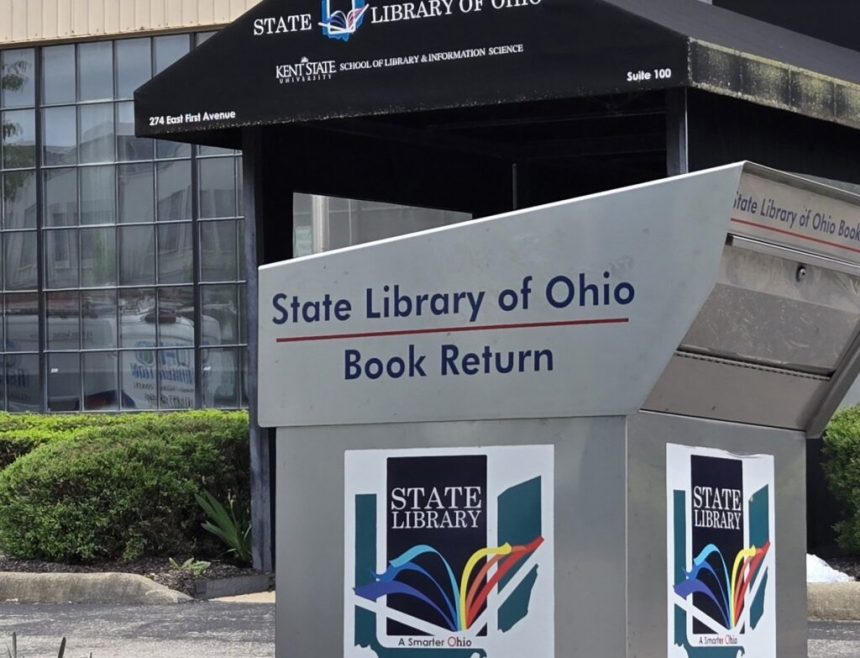The entrance to the State Library of Ohio. (Photo by Marty Schladen, Ohio Capital Journal.)
The State Library of Ohio is one of many libraries across the country awaiting legal battles over federal funding and congressional debates as to how much they’ll receive next year.
The library receives state funding, but in the past has received support from the Institute of Museum and Library Services, which serves as the federal bucket of funding for libraries and museums across the country.
Lawsuits
Earlier this year, President Donald Trump signed an executive order seeking to eliminate funding to the institute as part of slashing of funds in partnership with the Department of Government Efficiency, a non-governmental agency then run by Elon Musk. He attempted to eliminate the institute, among other arts and humanities cuts, in his previous administration as well.
SUBSCRIBE: GET THE MORNING HEADLINES DELIVERED TO YOUR INBOX
The American Library Association is part of a lawsuit attempting stop that executive order. The association said in their initial complaint that following the March order, the institute was “gutted” by DOGE. Staff were placed on administrative leave, and grants were canceled, all without congressional approval.
“Without grant funding or IMLS staff to process reimbursements, local and state libraries will suffer an immediate and irreparable inability to pay vendors or staff hired in reliance on IMLS’ promise to make these reimbursements,” attorneys for the ALA stated.
In May, the district court judge in the case granted a temporary pause in enforcement of the order “to preserve the status quo” as the case continued. However, in June, the judge denied a motion for a further pause to the executive order.
“While the court laments the executive branch’s efforts to cut off this lifeline for libraries and museums, plaintiffs have not established a substantial likelihood of success on the merits,” Judge Richard J. Leon wrote.
Most recently, the ALA filed a motion to end the case via summary judgment, which is an order by the judge that the case is cut-and-dry enough to rule without a trial or further proceedings.
The ALA, along with the advocacy group Democracy Forward, asked that a judge in a D.C. district court rule in their favor under violations of the constitution’s Separation of Powers Doctrine, among others. The groups called the actions of the Trump administration “arbitrary, capricious, an abuse of discretion” and “unconstitutional.”
Another lawsuit targeting the the executive order was filed by attorneys general in 21 states, not including Ohio. On Thursday, an appeals court upheld the previous court’s decision in that case, meaning the Trump administration still can’t enforce the executive order as the case goes on.
The beat goes on
As legal challengers await final decisions, libraries still have to open their doors and provide needed services.
“Local (library) budgets are tight enough, and not honoring those federal tax dollars will put communities in a crunch,” said Sam Helmick, president of the American Library Association.
Helmick said the loss of those previously mandated funds could mean reductions in services, and “could unintentionally cost state and local taxpayers more” because contracts have already been signed with consortiums and other resource organizations that are owed money, whether its federal monies as promised, or not.
(File photo by Catherine McQueen/Getty Images)
The State Library of Ohio is not a member of the ALA, but it does receive funds from the institute. The state agency uses the funds to bolster digital resources across the state and other resource-sharing programs with local libraries. State funds go toward conservation efforts within the state library, to keep Ohio’s founding documents and other historical artifacts properly stored.
The library’s funding mechanism on the state side changed slightly with the passage of the most recent state operating budget. Funds going to the State Library of Ohio were put into an operating expenses fund under the Public Library Fund umbrella. The expenses fund provides $9 million over the next two years to the state library, which State Librarian Mandy Knapp said was a cut of $245,000 in fiscal year 2026 and another $331,000 in 2027, compared to the House’s version of the budget.
“Unfortunately, our budget has faced significant reductions, resulting in the elimination of a substantial number of staff positions over time,” a spokesperson for the State Library of Ohio told the Capital Journal. “Flat funding for the State Library this year has contributed to a loss of 26% of our state funding over the last 20 years, leading to a 50% decrease in staff positions over that same time.”
On top of uncertainty as to how the lawsuits will resolve and less-than-desired state funding, the state library is awaiting final word on federal funding for the Institute for Museum and Library Services in fiscal year 2026, which is still being ironed out in both chambers of Congress.
‘Access and opportunity’
In 2025, the State Library of Ohio received $5.4 million from the IMLS’ Grants to States program, according to institute data.
The institute uses a population-based formula to distribute the funds to state library administrative agencies. Agencies use the funding directly or through “competitive sub awards” to libraries of all kinds.
Some of the federal funds the state library received through the federal program went toward monthly deaf storytimes, a digital microfilm scanner for newspapers and historical records, along with e-readers and e-books for home-bound Ohioans.
Other awards went to the Toledo Lucas County Public Library to support a Science of Reading project and more than $340,000 spread between 18 rural public libraries for technology training like computer instruction and one-on-on tutoring.
Without the funds, library users across the country could see limited access and longer lines for digital resources and even the loss of programs like summer reading and employment help.
“When federal funds are cut, communities lose access and opportunity,” ALA President Helmick said. “A reader delayed is a reader denied.”
Libraries have made strides to broaden their reach and tailor their services to their local communities, and have had to do so with thinner and thinner pocketbooks. For Helmick, the scrutiny over library funding is a distraction from other existing problems, when public support for libraries has remained strong.
“Teaching our children how to think instead of what to think has always been the American way,” Helmick said.
Federal funding for next year has survived a congressional hurdle, having passed out of committees in both the U.S. House and Senate.
The funding proposals are similar, with the U.S. House version recommending an IMLS budget of $291.8 million in 2026. This proposal is a $3 million cut from the funding the institute received in 2025, but it’s an about-face from President Donald Trump’s discretionary budget, which proposed only $6 million for the fiscal year.
The House Appropriations Committee specifically mentioned the IMLS’ “commitment” to working on the 250th anniversary celebrations for the signing of the Declaration of Independence happening next year in a Sept. 9 report.
“IMLS has a key role in supporting existing activities and new projects at the state and local levels that enhance civic engagement, innovation and community collaboration in preparation for the 250th Anniversary,” the committee stated in the report.









